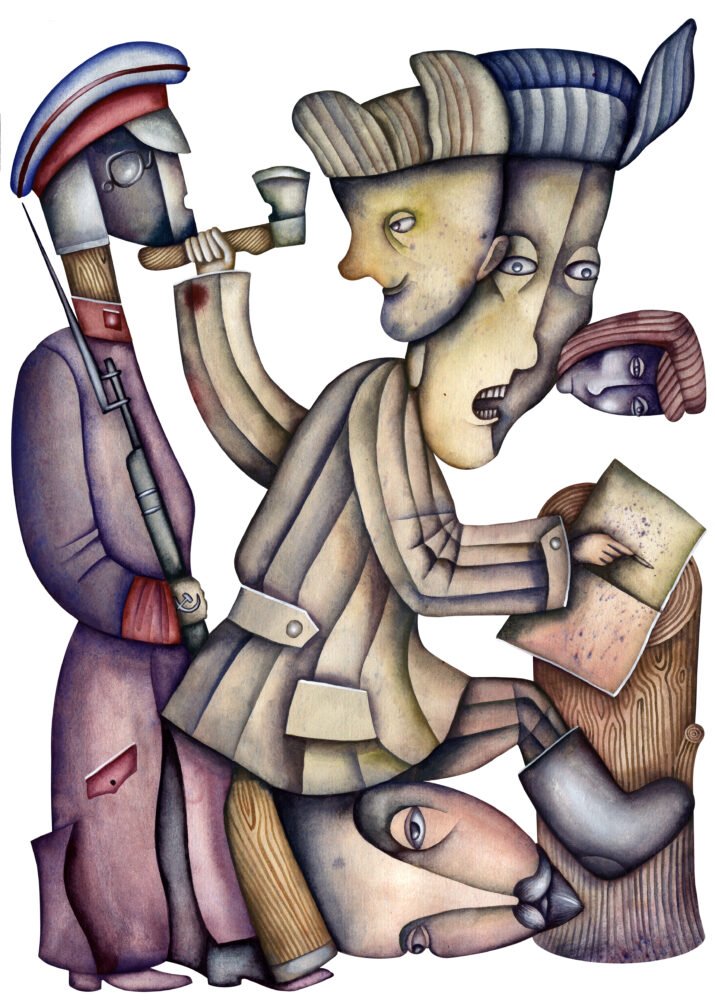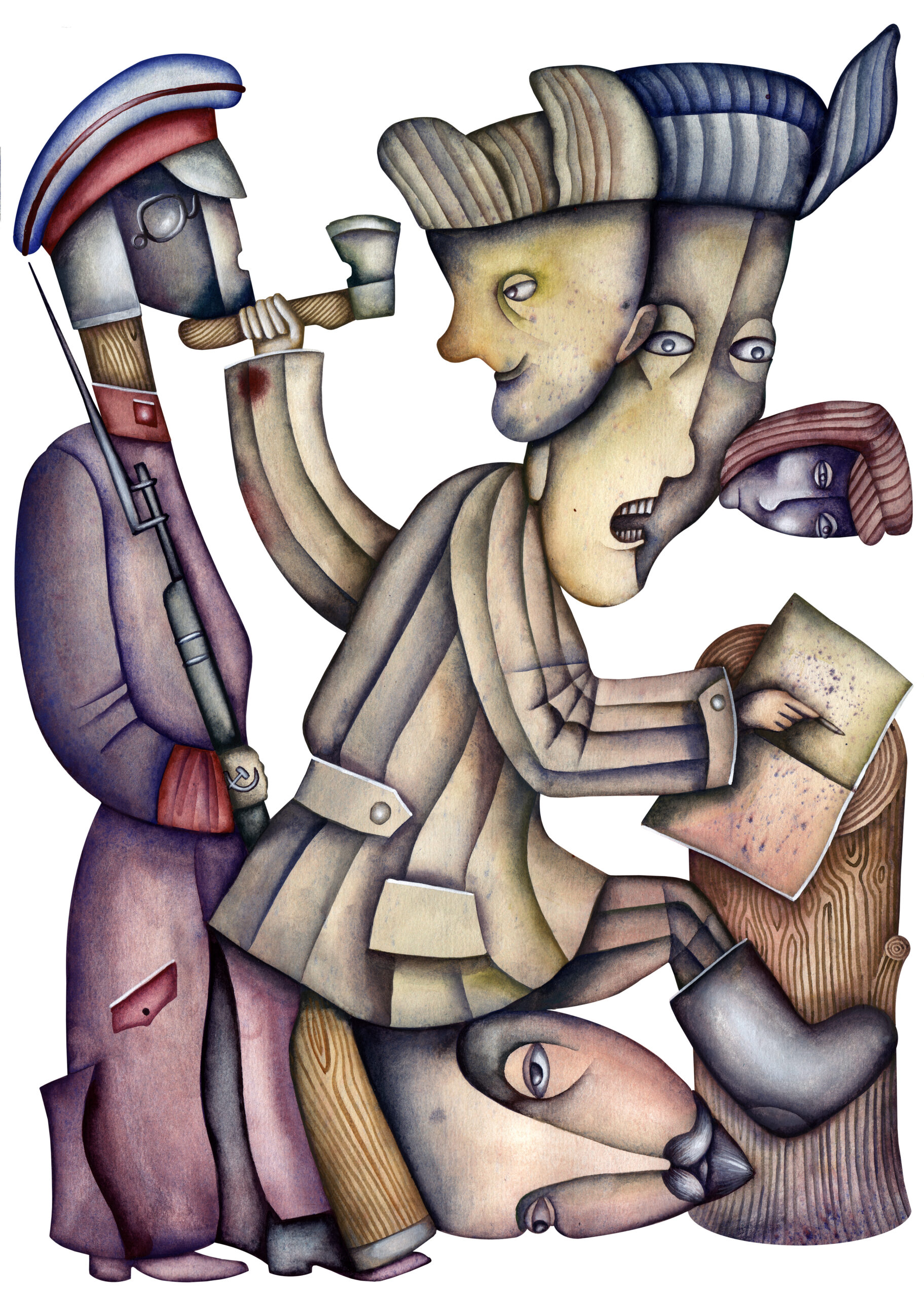
 When we have a quiet hour
When we have a quiet hour
We are lulled by sweet desires:
The sentry sleeping on the tower
And no current in the wires
—Igor Guberman
Recent events have shown that Russian history is prone to a regrettable cyclicity, based on the “longstanding life world” of “Soviet civilization” (Schlogel 2022), which has generated new monsters and marked Russia’s dramatic comeback to Stalinism—and even worse. In the face of the current resurrection of the “Soviet Leviathan,” the dark sides of high Stalinism—collectivization, repressions, ethnic cleansing, and the Gulag legacies—have acquired a renewed and macabre importance.
The Gulag, like an octopus, entwined Russian society with its tentacles during the Stalinist period (1927-1953). The system of correctional labor camps created in the early 1930s was meant to effect a radical modernization of the Soviet economy and transform wide swaths of Soviet society through a “reforging” (perekovka) and “re-educating” of the population based on hard work. For a long time, the Soviet forced labor experience was a popular reference in the multiple attempts at re-visioning, rewriting, re-presenting, and re-evaluating history; but today, it has become grounds for silencing and removal. In Western scholarship, critical approaches have advanced the state of knowledge on the Stalinist Gulag, primarily accentuating its social and cultural entanglements (David-Fox 2016; Barenberg 2022; Anderson 2022). At the same time, current Russian revisionism has almost erased the Gulag from the country’s historical and political agenda as well as from Russian history textbooks.
Iosif Stalin’s Gulag as a transformative project
The Bolshevik political and social modernity project, informed by the Enlightenment’s belief in technology and the human spirit, was about transforming nature and human society simultaneously. It aimed at securitizing resources and militarizing modernization. In reality, this project was informed less by the specific cultural imaginary of Marxist ideology and rather by Stalin’s mundane and practical political and military ambitions. From the beginning of the 1930s, the Russian space became contested as an epistemological and material site whose environment constituted a fault line of conflict and violence within the Bolshevik project. This confrontation produced epidemics, staggering prisoners’ mortality rates, and catastrophic environmental failures, and resulted in augmented state violence, a unique feature of the Stalinist period of Soviet history. As a result, the Gulag became a “crooked mirror” of Soviet society, which laid bare all its vices. According to Ivan Solonevich, “in the camps the foundations of Soviet power were reflected with the precision of an algebraic formula” (Solonevich 1999, 8). The project of transforming the natural and human environment through forced labor mobilization also revealed the backwardness of the Soviet state. Soviet forced labor networks resulted from brutal mobilization practices and operated a return to the conditions of the Middle Ages or to slavery. These networks rested on a flamboyant propaganda promising vigorous future growth and the replacement of outdated social norms by twentieth-century modern concepts, as nature and human beings were being simultaneously remolded.
The Gulag has demonstrated a remarkable continuity based on the cultural foundations of pre-revolutionary Russia. This continuity is seen not only in the “serfdom syndrome” repeatedly cited by memoirists but also in the way inmates have lived. In the past, quite often, the camps or camp-point centers were located in old manor houses, but camp leaders lived in their own vyezd (a troika with a nicely decorated carriage) or on estates where a “backyard farm” was located. Inmates’ forced unpaid labor was used as farm labor, and some inmates served as governesses for the leaders’ children. The Soviet illusion of control over nature also concealed unacknowledged dependencies on the environment and played out in full scale starting in 1937. This illusion revealed that the human and environmental factors influenced a vicious circle yielding local industrial failures and political repression during the so called “Great Terror” (1937-1939). This vicious circle entailed a range of repressive operations targeting various social and national groups in the Soviet Union. At the same time, there were intense propaganda campaigns fostering total mobilization in the struggle against external and internal enemies. To legitimize these operations, the “enemy of the state” was defined inclusively, encompassing not only political enemies but random victims emanating from broad social and political categories and backgrounds. Moreover, a pervasive, irrational fear of the Stalinist machinery at all levels of the Gulag’s hierarchy was aggravated by unpredictable seasonal climate variations, which largely contributed to the failure of mechanization. A flood of accusations about “wrecking” and “sabotaging” the Gulag empire emerged, followed by executions throughout that empire. Natural and human factors became intermingled in the way the Chekists investigated people accused of counterrevolutionary and sabotage acts. The VCHEKA was the “All-Russian Extraordinary Commission for Combatting Counterrevolution and Sabotage” and quickly assumed responsibility for arresting, imprisoning, and executing “enemies of the state,” which included the former nobility, the bourgeoisie, and the clergy.[1] Moreover, outbreaks of animal epidemics (epizootics), including brucellosis and other diseases widespread in the Gulag camps were on the rise in the late 1930s and invariably regarded as the “results of wrecking through livestock infection,” leading to class action criminal cases and executions.
However, as inhumane as this system was, it displayed a surprising level of condescension towards its mid- and low-ranking henchmen, as reflected in the fairly fortuitous fates of the hangmen and executioners who were active during the Great Terror. Many of them were later pardoned, and the Chekists who were released in spite of having violated “socialist legality” went on with their careers in the state security apparatus. Moreover, apart from welfare privileges (such as pensions and numerous other benefits), for decades to come the NKVD[2] (Ministry of Internal Affairs, later MVD) afforded these individuals confidentiality, anonymity, and security. Their involvement in the repressive operations of the Great Terror was denied by authorities; even their service within the NKVD ranks was concealed, often replaced in the record by another occupation such as “contracted work in timber felling.” It is precisely these numerous “ordinary” lives, which ended in peaceful, quiet, and secluded retirement, that exude an air of routine—or, in Hanna Arendt’s term, the “banality of evil”—and were a characteristic feature of the Stalinist terror.
Stalin’s human transformation project constituted another pillar of the Gulag. Moreover, not only was propaganda deemed an important component of Bolshevik cultural policies in the camps, but so was entertainment. Such entertainment channeled Soviet ideology and Russian culture to boost the fulfillment of production output plans; it also created a cultural order in which the prisoners and their guards received a common education, which led them to share Russian high culture and Soviet culture. These programs served to unite all Soviet citizens. The Gulag’s manifesto on cultural colonization was proclaimed by Semyon Firin, one of the main Chekist heroes: “The OGPU [Main Political Directorate] correctional labor camps are pioneers in the cultural development of our remote outskirts. The work of the camps is gradually turning the previously backward places of our Union into cultural and industrial areas” (Firin 1933, no page).
During the 1930s, the “reforging” policy—or perekovka—was promoted at the same time as the White Sea-Baltic canal was constructed, which coincided with the celebration of an assumed triumph of the hydrotechnical sector. The Gulag hailed the process of rehabilitating inmates as a major Soviet feat along with the canal construction—representing the transformation of nature by humans through redemptive and glorious labor. This transformation was also inscribed in Soviet literary works, newspaper articles, and theatrical productions at the time (Gorky 1934; Pogodin 1934). Moreover, the policy justified treating thieves and repeat offenders as “social allies” and granted them various privileges. Article 8 of the VKP(b) Central Committee decree “On the Belomorstroy” suggested that the OGPU—the early security and political police of the Soviet Union and a forerunner of the KGB—present to the Central Executive Committee a list of up to 500 individuals to be amnestied. It also called for the further provision of qualifications for the most talented shock workers among former repeat offenders and the supply of stipends. In the 1930s, a very significant portion of common prisoners serving time in the Gulag received a new lease on life and were able to start new careers working in construction; for example, some became law enforcement agents. The “reforging” policy came to an end through an order by Genrikh Yagoda, the People’s Commissar of Internal Affairs, on April 2, 1936; the order put the cultural and educational mission of the camps from then on entirely at the service of industrial production. However, two years later, the perekovka policy would become a central subject discussed at some of the central Gulag apparatus party meetings; indeed, the policy was openly chastised and condemned as having provoked arrogant behaviors on the part of the released criminals.
Stalinist flashbacks in modern Russia
The tragedy of Russian history lies in the fact that numerous inherent features of the repressive Soviet system have been resurrected on a massive—if openly unarticulated—scale in present-day Russia. A number of practices reminiscent of the Stalinist Gulag have again become an everyday reality for Russian convicts who are being molded for the so-called “special military operation.” Despite this changed context, the significance of this reforging practice and the rhetoric used to support it has remained the same. For example, Evgeny Prigozhin pardoned 124 criminals returning from the war zone on January 22, 2023, in an act that was painfully reminiscent of the solemn speeches by people’s commissars during the Stalinist era:
Neither your grandfathers, nor your grand-grandfathers, I believe, had ever participated in such nasty messes. Those who have seen Soledar know that Stalingrad takes a backseat. The Motherland and the people [of Russia] owe you. You are no longer former convicts but soldiers of the Wagner Private Military Company. And there is no such thing as former [Wagner] warriors (Mobilizatsiia. Novosti. Chto delat’, January 23, 2023).
Today’s “reforging” of prisoners and politics has led to convicts being divided between “political” and “other” (“criminal”) prisoners. While the former have been subjected to demoralizing practices via surveillance and humiliation in Russian prisons, the latter—a broad category of recidivists and common criminal offenders—have been reinvented into glorious warriors and “heroes of the Motherland.” In one of his pep talks, Prigozhin stressed that the longer someone has been in prison, the better candidate for recruitment: “We need preferably those with a minimum of 20 years left to serve” (Mobilizatsiia, February 2023). No one knows how many criminals have been pardoned upon returning from the war.
What are the ambitions and the scale of the “reforging” taking place in the Gulag in Russia today? Moreover, how are these ambitions different from those of the government during Soviet times? The current iteration of the practice may surpass the scale of its predecessor in terms of the promises made to those convicts who agree to participate in the current military actions. For example, they are being promised free access to the country’s leading universities, and they voting rights are being restored. However, many ex-prisoners have died during the military actions (Satanovsky 2022), so that this modern-day reforging could be seen as nothing but propaganda and a sheer manipulation to bring more former convicts into the war.
Researchers have repeatedly stressed that the contemporary penitentiary system in Russia is characterized by some elements of the Gulag and some of the coercive methods developed during the post-Soviet years (Anderson 2018). Alexei Navalny, a prominent victim of this system, stated that today’s Russian prison is “more or less a Soviet system. The only difference is the presence of a church in every prison camp” (Pallot 2023, transl. by author, 27:00). Moreover, the Russian mobilization campaign that started in September 2022 replicated a social atmosphere of “mobilization terror” that is reminiscent of Stalinist methods. Some people, for the most part randomly selected, were forcefully mobilized for the war with Ukraine, facing death at war or a prison term if they refused to enlist. Mostly, these people had been loyal to state authorities or had already served in the army. The words of Yevgenia Ginzburg, a well-known Gulag survivor in the 1980s fit today’s context: “In all that was happening in the country at that time, we were confronted with the monstrous and puzzling violation of human logic and total absence of common sense” (Ginzburg 1985). The recent mass mobilization of civilians by the Russian government, the enhanced state interference into the economy, and the creation of a large-scale coerced labor economy in the Russian Federation have confirmed that the shadow of the Gulag has re-emerged in Russia. Moreover, in light of an acute labor shortage, Russian enterprises involved in the fulfilment of the state’s defense projects (Gosoboronzakaz) have increasingly relied on prisoners’ labor, as they had in the past. Other groups have also been recruited, for example students. For example, beginning in early 2023, students at the Chita Polytechnic College were brought in to work in a number of the city’s factories, including Chita Power Station 2, which had been left without electricians after they were drafted to go to war (Mobilizatsiia. Novosti. Chto delat’? March 14, 2023).
Most challenges in Russia today are resolved through administrative measures, often in a rushed manner, which is reminiscent of what occurred in Stalin’s USSR. Moreover, this type of governance has been characterized by the immediate execution of orders coming from the authorities and the fear of those people responsible for implementation. Vyacheslav Molotov’s report to Stalin in the early 1930s, which was devoted to a review of resources on the eve of Soviet industrialization, is still relevant because it occurred in the same context of technological and infrastructural shortages as are present today. The only resources available and presented by Molotov as “unlimited” was the human resources, which is also true today.
The situation in today’s Russia can be said to replicate Stalin’s imperial ambitions, which were supported by violent forced labor mobilization experiments. These experiments generated unique “system imperatives,” political, cultural, and social practices, and power relationships. While the iteration of perekovka propagandistic campaigns has led to the successful reintegration of former prisoners into Russian society, society itself seems to have been precipitated into collective amnesia and silent fear, as it had been during the Stalinist period. This oblivion is reflected in the translation of verses by Evgeniya Berkovich, a theater director who was arrested in 2023 and is currently serving time as a political prisoner (translation by Sergey Dobrynin):
Google the prophecies, sit and relax.
Keep an eye out for sledgehammer and axe.
Go get plastered
Before you are blasted.
Don’t dig holes
For you can find bones.
We step on the graves
As if visiting friends.
We are going backwards, hell is under our feet,
And people’s enemies waiting to meet.
Ashes to ashes
And dust to dust.
No one will blame you
If you run away fast.
You have to run faster to stay in one place,
You have to lie low to get back in one piece.
This text is the result of a research project supported by the Gerda Henkel Stiftung, Dusseldorf, Germany.
Oksana Ermolaeva has a PhD in the History of Eastern and Central Europe from the Central European University, Budapest. She is a grantee of the Scholars at Risk Research Fellowship from Gerda Henkel Stiftung, 2023-2024, Dusseldorf, Germany.
References
Anderson, Klare. 2018. A Global History of Convicts and Penal Colonies. London: Bloomsbury Academic.
Barenberg, Alan. 2022. Rethinking the Gulag: Identities, Sources, Legacies. Bloomington: Indiana University Press.
David-Fox, Michael, ed. 2016. The Soviet Gulag: Evidence, Interpretation, and Comparison. Pittsburgh: University of Pittsburgh Press.
Firin, Semyon. 1933. “O velikoy pobede (Belmorstroy).” Bolshevik, no. 20: 68-85. http://moskva-volga.ru/o-velikoj-pobede-belmorstroj-s-firin-1933/)
Gorky, Maksim, Averbakh, Leopold, and Firin, Semyon, eds. 1934. White Sea Baltic canal named after Stalin: History of construction. Moscow.
Pallot, Judith. 2023. “Voina pokazala, chto Putin otnositsa k tyur’mam kak k resursu: imi effektivno ugrozhat’ neugodnym, v nikh mozhno verbovat soldat. Neuzheli on eto davno splaniroval?” Produced by Stitcher. Stitcher, February 14. Podcast, 27:00. https://www.stitcher.com/show/meduzaintheknow/episode/-211920792
Satanovsky, Serge. 2022. “Olga Romanova: Zaklychennykh rossiyan brosayt v boy pervymi.” Deutsche Welle Global Media Forum. August 12. https://www.dw.com/ru/olga-romanova-zaklucennyh-rossian-na-vojne-v-ukraine-brosaut-v-boj-pervymi/a-62793841
Schlogel, Karl. 2022. The Soviet Century: Archaeology of a Lost World, Princeton: Princeton University Press.
Solonevich, Ivan. 1999. Rossiia v kontslagere. Moscow: Astra sem’.
[1] The Soviet-era VCheka, (originally VCHEKA, an acronym derived from the Russian words for the All-Russian Extraordinary Commission for Combatting Counterrevolution and Sabotage) was established in December 1917. It was charged with the preliminary investigation of counterrevolution and sabotage acts. The Cheka was reorganized in 1922 as the State Political Directorate, or GPU. The GPU later became the OGPU (Joint State Political Directorate) and placed under the authority of the Council of People’s Commissars of the USSR.
[2] Established in 1917 as the NKVD under the authority of the Russian Soviet Federative Socialist Republic,[1] this agency was originally tasked with conducting regular police work and overseeing the country’s prisons and labor camps. It was disbanded in 1930, and its functions were dispersed among other agencies, only to be reinstated as an all-union commissariat in 1934.
Image Shutterstock | Allegory Of The Communist concentration camp GULAG.
Published on November 21, 2023.




